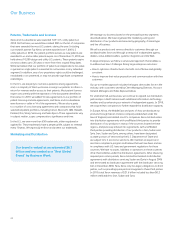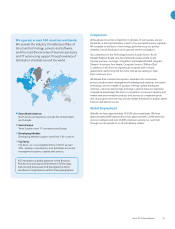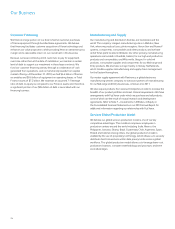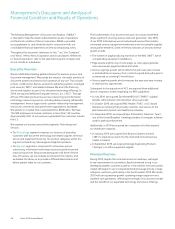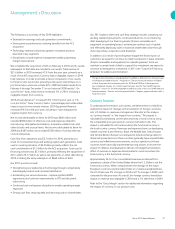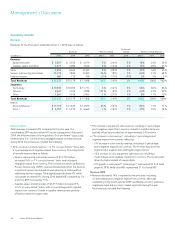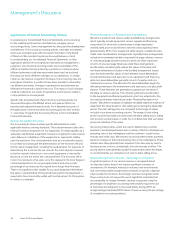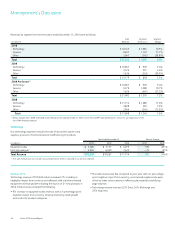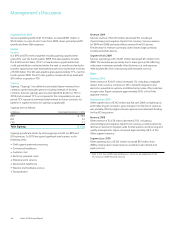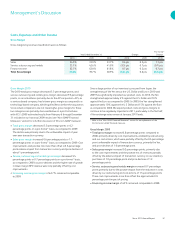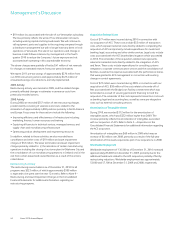Xerox 2010 Annual Report Download - page 33
Download and view the complete annual report
Please find page 33 of the 2010 Xerox annual report below. You can navigate through the pages in the report by either clicking on the pages listed below, or by using the keyword search tool below to find specific information within the annual report.
31Xerox 2010 Annual Report
Management’s Discussion
Historically, the majority of the bad debt provision related to our
finance receivables portfolio. This provision is inherently more difficult
to estimate than the provision for trade accounts receivable because
the underlying lease portfolio has an average maturity, at any time,
of approximately two to three years and contains past due billed
amounts, as well as unbilled amounts. The estimated credit quality of
any given customer and class of customer or geographic location can
significantly change during the life of the portfolio. We consider all
available information in our quarterly assessments of the adequacy
of the provision for doubtful accounts.
Bad debt provisions decreased by $103 million in 2010 and reserves
as a percentage of trade and finance receivables decreased to 3.3%
at December 31, 2010 as compared to 4.1% at December 31, 2009
and 3.4% at December 31, 2008. The decline in 2010 reflects the
improving trend in write-offs over the past year as well as the acquisition
of ACS. We continue to assess our receivable portfolio in light of the
current economic environment and its impact on our estimation of
the adequacy of the allowance for doubtful accounts. Refer to Note
4 – Receivables in the Consolidated Financial Statements for additional
information.
As discussed above, in preparing our Consolidated Financial Statements
for the three years ended December 31, 2010, we estimated our
provision for doubtful accounts based on historical experience and
customer-specific collection issues. This methodology was consistently
applied for all periods presented. During the five-year period ended
December 31, 2010, our reserve for doubtful accounts ranged from
3.0% to 4.1% of gross receivables. Holding all assumptions constant,
a 1-percentage point increase or decrease in the reserve from the
December 31, 2010 rate of 3.3% would change the 2010 provision by
approximately $98 million.
PensionandRetireeHealthBenetPlanAssumptions
We sponsor defined benefit pension plans in various forms in several
countries covering employees who meet eligibility requirements. Retiree
health benefit plans cover U.S. and Canadian employees for retirement
medical costs. Several statistical and other factors that attempt to
anticipate future events are used in calculating the expense, liability
and asset values related to our pension and retiree health benefit plans.
These factors include assumptions we make about the discount rate,
expected return on plan assets, rate of increase in healthcare costs,
the rate of future compensation increases and mortality. Differences
between these assumptions and actual experiences are reported as net
actuarial gains and losses and are subject to amortization to net periodic
benefit cost generally over the average remaining service lives of the
employees participating in the plans.
Cumulative actuarial losses for our defined benefit pension plans of
$1.9 billion as of December 31, 2010 were essentially unchanged from
December 31, 2009. Positive returns on plan assets in 2010 as compared
to expected returns offset a decrease in discount rates. The total
actuarial loss will be amortized over future periods, subject to offsetting
gains or losses that will impact the future amortization amounts.
Revenues on certain fixed-price contracts where we provide information
technology system development and implementation services are
recognized using the percentage-of-completion approach. Revenue
is recognized over the contract term based on the percentage of
development and implementation services that are provided during
the period compared with the total estimated development and
implementation services to be provided over the entire contract. These
contracts require that we perform significant, extensive and complex
design, development, modification and implementation activities for our
clients’ systems. Performance will often extend over long periods, and
our right to receive future payment depends on our future performance
in accordance with the agreement.
The percentage-of-completion methodology involves recognizing
probable and reasonably estimable revenue using the percentage of
services completed, on a current cumulative cost to estimated total cost
basis, using a reasonably consistent profit margin over the period. Due
to the longer-term nature of these projects, developing the estimates
of costs often requires significant judgment. Factors that must be
considered in estimating the progress of work completed and ultimate
cost of the projects include, but are not limited to, the availability of
labor and labor productivity, the nature and complexity of the work to
be performed and the impact of delayed performance. If changes occur
in delivery, productivity or other factors used in developing the estimates
of costs or revenues, we revise our cost and revenue estimates, which
may result in increases or decreases in revenues and costs. Such revisions
are reflected in income in the period in which the facts that give rise to
that revision become known. If at any time these estimates indicate the
contract will be unprofitable, the entire estimated loss for the remainder
of the contract is recorded immediately in cost. We perform ongoing
profitability analyses of our services contracts in order to determine
whether the latest estimates require updating.
AllowanceforDoubtfulAccountsandCreditLosses
We perform ongoing credit evaluations of our customers and adjust
credit limits based upon customer payment history and current
creditworthiness. We continuously monitor collections and payments
from our customers and maintain a provision for estimated credit losses
based upon our historical experience adjusted for current conditions.
We cannot guarantee that we will continue to experience credit loss
rates similar to those we have experienced in the past.
Measurement of such losses requires consideration of historical loss
experience, including the need to adjust for current conditions, and
judgments about the probable effects of relevant observable data,
including present economic conditions such as delinquency rates and
financial health of specific customers. We recorded bad debt provisions
of $188 million, $291 million and $188 million in SAG expenses in our
Consolidated Statements of Income for the years ended December 31,
2010, 2009 and 2008, respectively.



